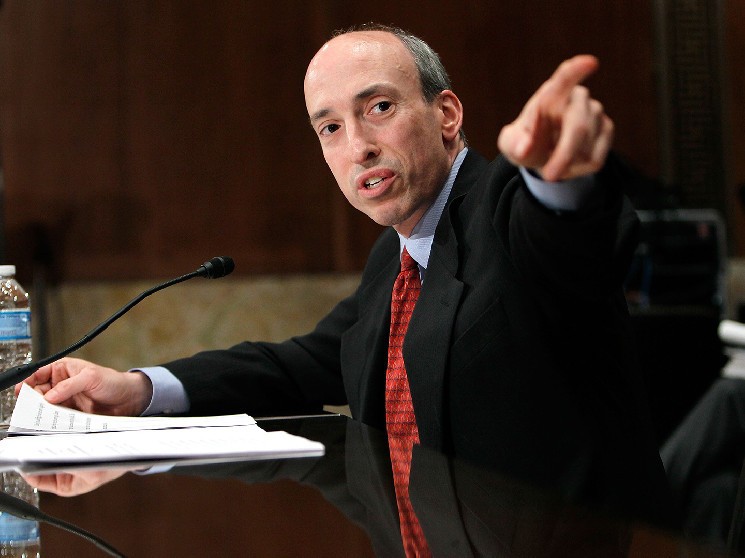Economic Unreality: What SEC ICO Precedents Mean for Ripple

The story of the initial coin offering in American law is a play in four acts: Kik Interactive, Telegram, LBRY and Ripple Labs.
With three of those four cases decided, and Ripple Labs exchanging dueling replies to motions for summary judgment on Friday, Dec. 2, we now enter the dénouement of a 10-year-long saga.
Preston Byrne, a CoinDesk columnist, is a partner at Brown Rudnick LLP.
The story begins with long-forgotten projects like Mastercoin and Counterparty, was blasted into public consciousness with projects like Ethereum and now slowly dies as American crypto developers shun the mother country for greener pastures abroad.
If Ripple loses, as I expect it will sooner or later, its defeat would be highly symbolic. The company and its associated protocol are among the longest-running and significant cryptocurrency projects in the world. XRP is practically a household name.
Back in 2012, when Ripple was founded, the term “initial coin offering” did not exist. Neither did enforcement actions against the then-miniscule crypto industry. In fact, the U.S. Securities and Exchange Commission (SEC) wouldn’t announce its first settlement for alleged registration violation until November, 2018 with the Airfox and Paragon ICOs. For context, Ripple’s network went into production on Jan. 1, 2013 – nearly six years earlier.
Apart from the fact that Ripple has sat in the top 10 coins by market cap for nearly a decade, the project also represented a unique approach to consensus at a time when alternative approaches to blockchain coordination of any kind were only a few years old.
Generally speaking, blockchains in the 2013-15 period worked in one of four ways:
- (1) proof-of-work, which requires computation energy to secure the network
- (2) proof-of-stake, which enables token holders to validate blocks
- (3) permissioned, i.e., where block creators are chosen by some entity, and
- (4) that weird thing Ripple does.
Ripple utilizes a novel consensus mechanism where a list of nodes, the so-called “UNL” or “Unique Node List,” conduct round-robin voting until 80% of them agree as to which transactions should be appended to the end of a chain. This is similar to a model more commonly known today as delegated proof-of-stake (except, without the stake). Tendermint or Cosmos take similar approaches to this voting process, except without the UNL (and markedly more decentralization).
The advantages of this round robin approach, it was claimed by Ripple’s proponents, are that the network can process many more transactions at far lower cost. The disadvantages, detractors say, are that it requires a higher degree of trust and is not truly decentralized.
See also: SEC Wants to ‘Remake the Law,’ Rather Than ‘Apply It,’ | Opinion
Thankfully, Ripple’s legal troubles are not about the protocol – they’re about the tokens. On genesis, Ripple Labs or its predecessor OpenCoin entity minted 100 billion XRP tokens, which were subsequently distributed to the company and early officers and then sold into the wider crypto markets to fund Ripple Labs’ operations.
At the time, there was much spirited debate about whether tokens sold in such a manner constituted securities. On one side were crypto entrepreneurs who claimed that token sales could serve as a lightly regulated governance mechanism and crowdfunding tool. On the other were many lawyers, myself included, who thought that the SEC would eventually get wise and crack down on the practice.
As we now know, the skeptics were right.
The first ICO to go down in a big way was Kik Interactive. Kik was, or rather still is, a lightly-used messaging app which pivoted into crypto at the height of the first great ICO boom in 2017. Kik sold tokens directly to the public without a registration statement in effect. The SEC sued and, 16 months later, Kik lost on a motion for summary judgment.
Telegram was the Commission’s next scalp. Telegram is a popular, allegedly encrypted messaging app founded by Russian billionaire Pavel Durov. Famously, despite being one of the most used messaging apps on the planet, Telegram generates no revenue. To remedy this, Telegram issued and sold a staggering $1.7 billion worth of cryptocurrency tokens in various private fundraising transactions via private placement over the course of 2018.
Telegram differed from Kik Interactive mainly in that Telegram sold tokens first via private placement to high net worth and offshore investors, who would presumably later unload those tokens onto U.S. markets and thus to U.S. retail purchasers. Mere days before the tokens were to be issued, the SEC sued Telegram and obtained an emergency restraining order halting the token conversion. Here, too, the SEC would quickly win on a motion for preliminary injunction. The official Telegram token project died immediately (but has continued on in various and unrelated forms).
LBRY (pronounced “Library”) was the next project on the chopping block. LBRY is a reimagining of YouTube with decentralized monetization tools, designed to solve the problem of politically-motivated censorship at companies like Google and Facebook. The token performed a real function in a real application. The sale of that token, however, was deemed to be an offering of investment contracts.
As in Kik Interactive and Telegram, LBRY too lost a motion for summary judgment, this time in New Hampshire. LBRY has said that “LBRY Inc. will likely be dead in the near future.”
This brings us to the present day. The SEC argues that between 2013 and 2020 Ripple raised $1.3 billion by selling XRP, which represented an “investment contract.” On Dec. 2, the SEC and Ripple exchanged dueling motions in what should be the last shots fired (or at least among the last shots fired) between them, before a judge in the Southern District of New York will rule, once again, on the legality of a token project.
Boiling down Ripple’s argument in this case to a single line on Twitter, company counsel Stuart Alderoty resorted to something akin to denial. He argued, among other things, that there is no investment contract because there is no formal contract between Ripple and XRP purchasers, and that the tokens were sold for consumptive use.
The SEC, for its part, refers to “economic reality” of Ripple’s sales not less than 15 times, asking the court to look “beyond boilerplate disclaimers” to the facts as they stand – including who bought tokens and how they were used. This economic reality allegedly “forecloses any argument that Ripple offered and sold XRP primarily for consumptive use.”
Reviewing the precedent lawsuits, it’s pretty clear which argument has been more successful in federal courts. In Kik, Judge Hellerstein wrote that “form should be disregarded for substance and the emphasis should be on economic reality,” (citing 1967’s Tcherepenin v. Knight, 389 U.S. 332, 336).
In Telegram, Judge Castel pointed out “Congress intended the application of [the securities laws] to turn on the economic realities underlying a transaction, and not on the name appended thereto,” (citing Glen-Arden v. Constantino, 493 F.2d 1027, 1034 (2d Cir. 1974)).
See also: SEC Could Use BlockFi as Object Lesson for Clear Crypto Rules | Opinion
In LBRY, Judge Barbadoro wrote that “the focus of the inquiry is on the objective economic realities of the transaction rather than the form the transaction takes,” (citing United Housing Foundation v. Forman, 421 U.S. 837, 848 (1975)).
The SEC concluded its reply brief to Ripple and the court by stating “the registration regime established by the federal securities laws does not regulate ‘industries.’ It regulates conduct…for the benefit of investors.”
Does it really?
At this point, the crypto industry has more or less resigned itself to the fact that a garden-variety ICO likely satisfies all of the limbs of the Howey Test, a foundational set of standards to determine what is a security. I expect the outcome of the Ripple litigation will only confirm that.
However, there is another economic reality that needs to be considered: today, it is abundantly clear crypto is never going away. For all the precedents discussing “economic reality,” the more material fact is that there are hundreds of millions of crypto users around the globe, and that number is growing exponentially, and many are Americans.
Telling next-generation crypto projects that the only path to compliance is to “come in and register” or drop dead is like trying to take a Ford Model T into space. Crypto’s basic mode of operation is by self-custody and directly peer-to-peer transactions over the Internet, not via paper forms signed with wet ink and mailed to a transfer agent or broker-dealer. There are no national securities exchanges which support crypto asset trading. The SEC won’t even approve a regulated exchange-trade fund (ETF), despite many proposals and much market demand. The list goes on.
It’s pretty clear that a huge class of investors doesn’t want what the SEC’s selling. In fact, they want the opposite. Millions of digital natives use trustless smart contracts daily for loans and other financial beasties, or grant and purchase assets like fractional royalty cash flows. They do so in an instant, from anywhere in the world, with anyone in the world, on handheld supercomputers smaller than a chocolate bar. Very soon they will do so with the assistance of artificial intelligence (AI). Investors will literally have superhuman abilities at their fingertips.
For the last six years, crypto has accepted the economic realities of a Depression-era regulatory scheme. The only question for America, at this juncture, is whether we want to back off from that regime just a little bit so we can nurture and supervise these new crypto companies right here at home – or persist, and drive them offshore and supervise these new businesses here at home.
The old ways are finished, whether Congress likes it or not.
This article is excerpted from The Node, CoinDesk’s daily roundup of the most pivotal stories in blockchain and crypto news. You can subscribe to get the full newsletter here.






 Bitcoin
Bitcoin  Ethereum
Ethereum  Tether
Tether  USDC
USDC  TRON
TRON  Dogecoin
Dogecoin  Cardano
Cardano  Bitcoin Cash
Bitcoin Cash  Chainlink
Chainlink  Monero
Monero  LEO Token
LEO Token  Zcash
Zcash  Stellar
Stellar  Litecoin
Litecoin  Hedera
Hedera  Dai
Dai  Cronos
Cronos  Tether Gold
Tether Gold  OKB
OKB  Ethereum Classic
Ethereum Classic  KuCoin
KuCoin  Gate
Gate  Algorand
Algorand  Cosmos Hub
Cosmos Hub  VeChain
VeChain  Tezos
Tezos  Dash
Dash  TrueUSD
TrueUSD  Stacks
Stacks  IOTA
IOTA  Decred
Decred  Basic Attention
Basic Attention  Theta Network
Theta Network  NEO
NEO  Synthetix
Synthetix  Qtum
Qtum  Ravencoin
Ravencoin  DigiByte
DigiByte  0x Protocol
0x Protocol  Nano
Nano  Zilliqa
Zilliqa  Holo
Holo  Siacoin
Siacoin  Numeraire
Numeraire  Waves
Waves  BUSD
BUSD  Status
Status  Enjin Coin
Enjin Coin  Pax Dollar
Pax Dollar  Ontology
Ontology  Lisk
Lisk  Hive
Hive  Steem
Steem  Huobi
Huobi  OMG Network
OMG Network  NEM
NEM  Bitcoin Gold
Bitcoin Gold  Augur
Augur  HUSD
HUSD